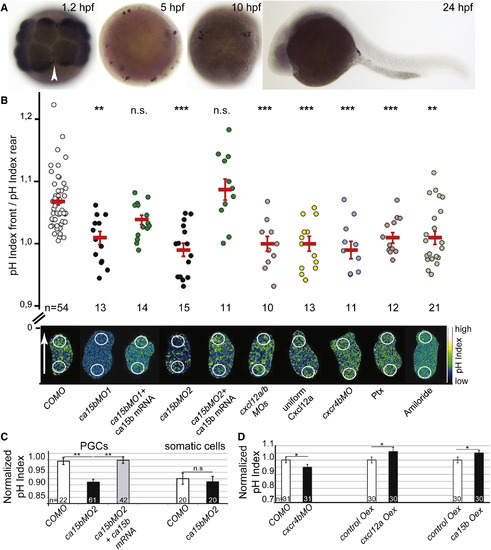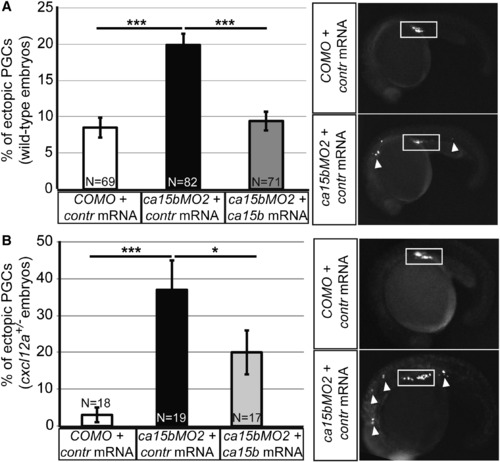- Title
-
Chemokine-Dependent pH Elevation at the Cell Front Sustains Polarity in Directionally Migrating Zebrafish Germ Cells
- Authors
- Tarbashevich, K., Reichman-Fried, M., Grimaldi, C., Raz, E.
- Source
- Full text @ Curr. Biol.
|
Ca15b and Cxcl12 Signaling Control the Polar pH Distribution in PGCs (A) Expression pattern of ca15b RNA in embryos at 1.2, 5, 10, and 24 hpf (blue staining). The arrowhead points at the position of the germplasm. (B) Polar pH distribution in PGCs depends on the function of Ca15b, on Cxcl12 chemokine gradient, on G protein signaling, and on Na+/H+ exchangers. The graph presents average pH index ratios between the front and the rear of migrating PGCs in 7–8 hpf embryos injected with the following: control morpholino (COMO), ca15b morpholino (ca15bMO1 and ca15bMO2), ca15b morpholino 1 and 2 along with morpholino-insensitive ca15b mRNA to restore Ca15b function, combined Cxcl12a and Cxcl12b morpholinos (cxcl12a/b MOs) for chemokine depletion, cxcl12a RNA for uniform Cxcl12a distribution, cxcr4b morpholino (cxcr4bMO), and Ptx RNA for disruption of the chemokine signaling pathway. Embryos were soaked in amiloride to interfere with the activity of Na+/H+ exchangers. Lower panel of images presents examples of PGCs with the corresponding treatments. Images were acquired using a confocal microscope. White circles depict areas at the front and back of PGCs used for pH index measurements. The white arrow indicates the direction of migration. (C) Graphs show average whole-cell pH index intensity values in PGCs and somatic cells at 6–7 hpf following knockdown and restoration of Ca15b activity (labeling as in B). (D) Graph presenting average global pH index levels in PGCs subjected to cxcr4b knockdown (cxcr4bMO) and Cxcl12a or Ca15b overexpression (Oex). n denotes the number of PGCs analyzed. p < 0.05, p < 0.01, p < 0.001 as determined by the Student’s t test. Error bars represent SEM. |
|
ca15b Knockdown Impairs PGC Migration (A) Graph shows the percentage of ectopic PGCs from total PGC number in wild-type embryos at 24 hpf. (B) Graph presents the average percentage of ectopic PGCs in 24 hpf embryos heterozygous for a mutation in cxcl12 (medusa mutation). Right panels show representative images of the PGC positioning in control and ca15b morphant embryos in wild-type (A) and in medusa+/- embryos (B). N is number of embryos analyzed. White boxes depict the normal position of PGCs in 24 hpf embryos, arrowheads point at PGCs located in ectopic positions. p < 0.05, p < 0.001 as determined by the Student’s t test. Error bars depict SEM. |

ZFIN is incorporating published figure images and captions as part of an ongoing project. Figures from some publications have not yet been curated, or are not available for display because of copyright restrictions. |


